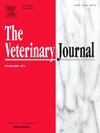Seasonal dynamics of mastitis in Gir cows: A comprehensive thermographic assessment
IF 3.1
2区 农林科学
Q1 VETERINARY SCIENCES
引用次数: 0
Abstract
Mastitis is a pervasive inflammatory disease of the mammary gland. It poses substantial challenges to global dairy farming by reducing milk quality, impacting animal welfare, and incurring substantial economic losses. This study hypothesized that infrared thermography (IRT) could serve as a non-invasive diagnostic tool for detecting sub-clinical (SCM) and clinical mastitis (CM) in Bos indicus (Gir) cows across diverse seasonal conditions. Thermographic parameters, including udder and short-milking-tube (SMT) temperatures, were evaluated in conjunction with the California Mastitis Test (CMT) and somatic cell count (SCC). Receiver operating characteristic (ROC) analysis assessed the diagnostic performance of IRT, and Pearson's correlation coefficients were computed to explore relationships between thermal metrics, SCC, and CMT scores. The findings revealed temperature differences (p < 0.01) in the eyeball, SMT, and udder skin surface across pre-milking, milking, and post-milking phases, with notable seasonal variations among healthy, SCM, and CM quarters. ROC analysis demonstrated higher sensitivity, specificity, and accuracy for CM cases than SCM across all thermographic parameters. These findings confirmed that IRT effectively captured seasonal and lactation phase-specific variations in udder and teat temperatures, along with SMT temperature variations during the milking phase. These results underscore IRT’s efficacy in detecting inflammation-induced thermal variations, offering a reliable, non-invasive approach for early mastitis diagnosis. This study highlights the potential of IRT to transform mastitis detection in Bos indicus breeds by enabling timely interventions and enhancing herd management strategies. Its integration into precision livestock farming aligns with global efforts to promote sustainable dairy production and improve animal welfare.
奶牛乳腺炎的季节性动态:一个全面的热成像评估
乳腺炎是一种普遍的乳腺炎性疾病。它降低了牛奶质量,影响了动物福利,并造成了巨大的经济损失,给全球奶牛养殖业带来了重大挑战。本研究假设红外热像仪(IRT)可以作为一种非侵入性诊断工具,用于检测不同季节条件下印度母牛的亚临床(SCM)和临床乳腺炎(CM)。热成像参数,包括乳房和短乳管(SMT)温度,结合加州乳腺炎测试(CMT)和体细胞计数(SCC)进行评估。受试者工作特征(ROC)分析评估IRT的诊断性能,并计算Pearson相关系数以探讨热指标、SCC和CMT评分之间的关系。研究结果显示,在挤奶前、挤奶和挤奶后阶段,眼球、SMT和乳房皮肤表面的温度差异(p <; 0.01),在健康、SCM和CM季度之间存在显著的季节性变化。ROC分析显示CM病例在所有热成像参数上比SCM具有更高的敏感性、特异性和准确性。这些研究结果证实,IRT有效地捕获了季节性和哺乳期乳房和乳房温度的特定变化,以及挤奶阶段SMT温度的变化。这些结果强调了IRT在检测炎症引起的热变化方面的有效性,为早期乳腺炎诊断提供了可靠的、非侵入性的方法。这项研究强调了IRT通过及时干预和加强畜群管理策略来改变母牛品种乳腺炎检测的潜力。它与精准畜牧业的结合与全球促进可持续乳制品生产和改善动物福利的努力相一致。
本文章由计算机程序翻译,如有差异,请以英文原文为准。
求助全文
约1分钟内获得全文
求助全文
来源期刊

Veterinary journal
农林科学-兽医学
CiteScore
4.10
自引率
4.50%
发文量
79
审稿时长
40 days
期刊介绍:
The Veterinary Journal (established 1875) publishes worldwide contributions on all aspects of veterinary science and its related subjects. It provides regular book reviews and a short communications section. The journal regularly commissions topical reviews and commentaries on features of major importance. Research areas include infectious diseases, applied biochemistry, parasitology, endocrinology, microbiology, immunology, pathology, pharmacology, physiology, molecular biology, immunogenetics, surgery, ophthalmology, dermatology and oncology.
 求助内容:
求助内容: 应助结果提醒方式:
应助结果提醒方式:


